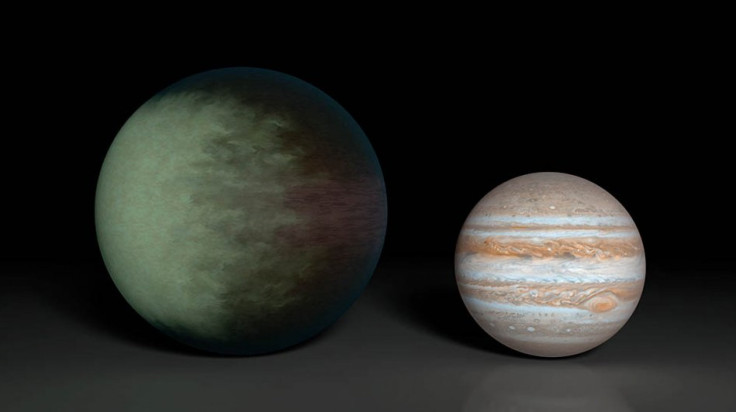Cloudy Kepler-7B: Scientists Create First Cloud Map Of Planet Outside Our Solar System

If you've ever wondered what cloud watching would be like on a planet outside our solar system, NASA is offering the first, hazy glimpse.
Using data collected form NASA's Kepler and Spitzer space telescopes, a team of astronomers have created the first cloud map of a planet outside of our solar system. Named Kepler-7b, the Jupiter-like exoplanet "is marked by high clouds in the west and clear skies in the east," says a statement from NASA's Jet Propulsion Laboratory. Data from Spitzer has been used in earlier projects to produce temperature maps of distant planets. But the Kepler-7b cloud map provides a unique view of one of the more than 150 exoplanets that Kepler has discovered to exist outside of our solar system.
"By observing this planet with Spitzer and Kepler for more than three years, we were able to produce a very low-resolution 'map' of this giant, gaseous planet," said Brice-Olivier Demory of Massachusetts Institute of Technology. Demory was the lead author of a paper on the map that has been accepted to be published in Astrophysical Journal Letters. He added that scientist "wouldn't expect to see oceans or continents on this type of world, but we detected a clear, reflective signature that we interpreted as clouds."
Using its visible-light observations, Kepler captured the moon-like phases of Kepler-7b, reports National Geographic's Star Struck. This data was then used to create a map that revealed a bright spot on the planet's western hemisphere. Scientists were intrigued to learn whether the spot was caused by clouds or heat and combined infrared light images gathered by Spitzer to help them uncover what created the spot. Spitzer measured the Kepler-7b's temperature to be between an estimated 1,500 and 1,800 degrees Fahrenheit, which is fairly low for how close the planet orbits its star. Astronomers concluded that since the planet was too cool for its temperature to be creating the bright light seen by Kepler, "light from the planet's star is bouncing off cloud tops located on the west side of the planet."
"Kepler-7b reflects much more light than most giant planets we've found, which we attribute to clouds in the upper atmosphere," said Thomas Barclay, a Kepler scientist at NASA's Ames Research Center. "Unlike those on Earth, the cloud patterns on this planet do not seem to change much over time -- it has a remarkably stable climate."
Scientists now hope to employ similar mapping methods to study the atmospheres of other exoplanets with sizes and compositions comparable to Earth. The Kepler telescope is no longer hunting for planets due to issues with its rotating wheels. But teams continue to pour over the more than four years worth of data collected before it was deemed unusable.
© Copyright IBTimes 2024. All rights reserved.
Join the Discussion






















